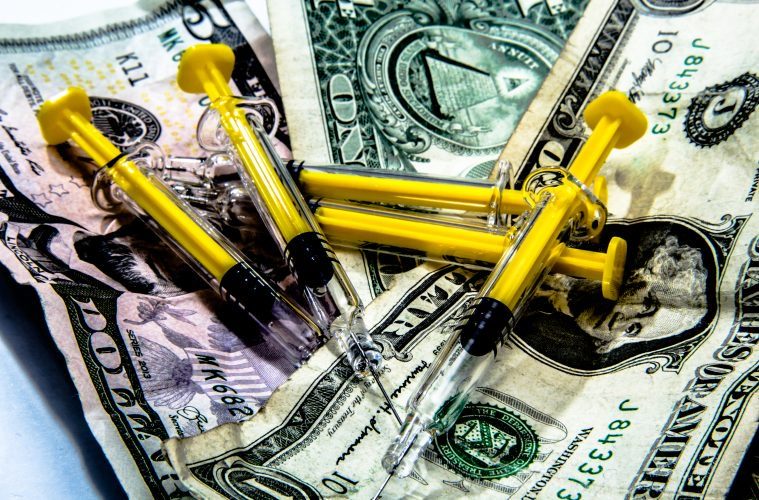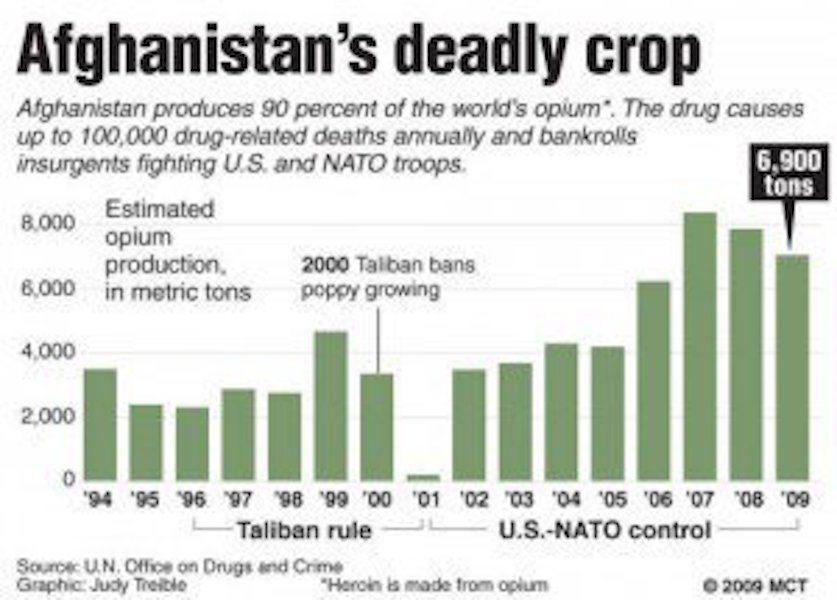A recent study published in the Journal of the American Chemical Society titled "Development of a Clinically Viable Heroin Vaccine" has been making recent headlines, hinting at fewer heroin users in the United States. The irony here is that taxpayer dollars are being spent to develop a vaccine against drug users supporting the very drug trade the U.S. government and the medical industry have so heavily invested in maintaining.
The U.S. government's role in the heroin (or opium) industry began during the Vietnam War and has continued ever since, moving from South East Asia to Afghanistan to the United States. The opium epidemic was fuelled by the government, and continues to worsen thanks to Big Pharma and the medical industry.
Even if this vaccine were successfully developed and distributed, would it really make a difference? Would it combat our addictive tendencies and would the U.S. government and Big Pharma then stop pushing drugs on us?
How Successful Is This Heroin Vaccine?
Researchers from the Scripps Research Institute (TSRI) are saying that this vaccine could be used to successfully treat heroin addicts, as the vaccine apparently dulls the "high" felt from heroin. Findings thus far have proven to be effective for up to eight months after being injected.
Essentially, the vaccine tells the immune system to create antibodies against heroin and the psychoactive products within it that produce the user's "high." Like many other vaccines, the vaccine does so by exposing the immune system to part of the heroin molecule's structure, and so when users try to get high again, the antibodies neutralize the heroin molecules before they can reach their state of "euphoria."
"This validates our previous rodent data and positions our vaccine in a favorable light for anticipated clinical evaluation," study leader Kim Janda said in a statement. "We believe this vaccine candidate will prove safe for human trials."
The researchers hope that by taking away the pleasurable aspect of the drug, users will no longer see a reason to keep taking it.
The researchers tested the vaccine on monkeys and found that it was successful in many cases, proving particularly effective within the first month after administering it, although in some cases the vaccine's effects lasted for up to eight months.
In addition, two of the monkeys tested in the study had been vaccinated in a prior study conducted seven months beforehand. These monkeys showed a higher response to the vaccine, which the researchers suggested could mean that long-term immunity to heroin could be achievable in the future (source).
Concerns Regarding Vaccines
Many vaccines contain harmful chemicals, including mercury and aluminum. This begs the question: Is it really worth it to inject heroin addicts with these chemicals if it could potentially harm their bodies? I personally believe that we should be spending this money on more natural therapies that deal with the root cause of the issue: our addictive tendencies.
It's also important to note that mercury can be passed down generation after generation, so this isn't just affecting you, it's also going to affect your current or potential future children and grandchildren.
Perhaps the most controversial element of vaccines is the link that some of them have to autism. The vaccine-autism link gained a lot of traction after CDC scientist Dr. William Thompson publicly apologized for falsifying research, much of which was considered "pro-vaccine."
The correlation between vaccines and autism is very real, and has been proven time and time again in relation to many vaccines, including the MMR vaccine. A study published by Dr. Brian Hooker, PhD and previous CDC scientist, in the peer-reviewed journal Translational Neurodegeneration, found up to a 340% increased risk of autism in African American boys receiving the Measles-mumps-rubella (MMR) vaccine. You can read more about this specific study in our CE article here.
The vaccine-autism link has even held up in courts, giving parents peace of mind and punishing Big Pharma companies. In one case, the Italian Health Ministry admitted that the MMR vaccine specifically caused autism in a 9-year-old boy. You can read more about that case in our CE article here.
A paper published in 2012 by Dr. Stephanie Seneff, Senior Research Scientist at the MIT Computer Science and Artificial Intelligence Laboratory, argues that severe adverse reactions to the chemicals (like aluminum) within vaccines are linked to life-threatening conditions associated with the heart and brain. The paper goes on to argue that there is a relationship between autism and acute adverse reactions to vaccinations.
As Dr. Seneff explains:
Mentions of autism in VAERS increased steadily at the end of the last century, during a period when mercury was being phased out, while aluminum adjuvant burden was being increased. Using standard log-likelihood ratio techniques, we identify several signs and symptoms that are significantly more prevalent in vaccine reports after 2000, including cellulitis, seizure, depression, fatigue, pain and death, which are also significantly associated with aluminum-containing vaccines. We propose that children with the autism diagnosis are especially vulnerable to toxic metals such as aluminum and mercury due to insufficient serum sulfate and glutathione. A strong correlation between autism and the MMR (Measles, Mumps, Rubella) vaccine is also observed, which may be partially explained via an increased sensitivity to acetaminophen administered to control fever.Another paper published by Professor Christopher Shaw and Dr. Lucija Tomljenovic of the University of British Columbia showed that vaccines with aluminum adjuvants increase the risk of developing autism, autoimmune diseases, and neurological problems later in life. A demonstrated neurotoxin, aluminum is the only approved adjuvant in the U.S. Its use presents the risk of brain inflammation, autoimmunity, and other adverse health consequences. (source)
If the heroin vaccine contains any of these chemicals, or any other potentially harmful chemicals, do we really think that we should be injecting it into heroin users? Drug users often put their bodies under added stress to begin with, meaning their bodies are likely very unhealthy already. If your body is already under stress, do you really want to add more stress and toxicity to it?
The U.S. Government and Big Pharma's Involvement in Heroin/Opium
To clarify, heroin is made from opium. Opium is removed from the poppy plant, which is then refined into morphine, and can then be refined into heroin. So, if you're an opium supplier, you could also be considered a heroin supplier. Now, how does all of this relate to the U.S. government and Big Pharma?
In Southeast Asia (SEA) during the Vietnam War, the CIA worked alongside Laotian general Vang Pao in an effort to help make Laos the world's largest exporter of heroin. The CIA actually owned and operated a covert drug smuggling airline, referred to as Air America, which was used to transport numerous goods, including heroin. The CIA then flew drugs all over SEA, allowing the Golden Triangle (parts of Burma, Thailand, and Laos) to become the world hub for heroin. You can read more about Air America in our CE article here.
Mainstream media has even addressed this issue, as the History Channel just came out with a new series titled America's War on Drugs which discusses the CIA's role in the heroin drug trade, as well as many other drugs, which you can read more about in our CE article here.
According to a New York Times article written in 1993, the CIA's involvement with the heroin industry actually began slightly before the Vietnam War. During the Korean War, in 1950, the CIA allegedly traded weapons and heroin in exchange for intelligence.
Well, it seems the CIA's "heroin problem" didn't start nor end in SEA.
Afghanistan is another country with a complicated history of involvement in the opium and heroin industries, much of which implicates the CIA. In the 1980s, CIA-supported Moujahedeen rebels were heavily involved in drug trafficking heroin. The CIA supplied trucks and mules, which were used to transport opium.
Despite the fact that Afghanistan supplied approximately 50% of the heroin used by Americans, the U.S. failed to intervene or investigate the Afghan drug industry for years. Instead, many of the individuals trafficking the drugs in Afghanistan were actually trained, armed, and funded by the CIA at the time.
Opium production came to a gradual halt thanks to Taliban rule. By 2000, the Taliban had completely banned opium production, practically eradicating 90% of the world's heroin. The following UN diagram outlines the history of opium production in Afghanistan:
As you can see, after 9/11 occurred and the U.S. invaded Afghanistan, opium production suddenly skyrocketed. There have been tons of photos of U.S. soldiers guarding the opium fields, yet today, more than a decade later, they still have not destroyed them and the business is booming (view some of the photos here).
It's no secret that 9/11 was an inside job, otherwise referred to as a false-flag terrorist attack. If you didn't know that, please read this CE article. Many have speculated that one of the main reasons the U.S. government orchestrated the 9/11 attack is so that they could gain full control over the opium trade in Afghanistan. You can read more about that in our CE article here.
There's no question that the U.S. government is knee deep in the opium/heroin drug trade. So, how does Big Pharma relate to all of this?
Big Pharma is largely responsible for the opioid epidemic in North America. We see more and more overdoses and addictions related to these drugs, each year and it all stems from Big Pharma and doctors overprescribing medication and understating the side effects and addictive tendencies. This issue isn't new, however; it actually started decades ago.
"[The marketing effort for opioid sales] was a promotional campaign unlike we have ever really seen," explains Dr. Andrew Kolodny, the Chief Medical Officer for the Phoenix House treatment centers and co-founder of Physicians for Responsible Opioid Prescribing. "Drug reps were going to family care doctors, and insisting that OxyContin had no real risks—only benefits. What they were selling was the idea that pain was a disease, and not a symptom."
This problem can be seen all over North America. In the U.S. and Canada, pharmaceutical giant Purdue has made over $30 billion USD from OxyContin alone since the mid-1990s. Purdue was actually largely responsible for the marketing campaign in support of these drugs, and in 2001, spent $4.6 million on OxyContin advertisements in medical journals.
It's clear that the U.S. government and Big Pharma are heavily responsible for creating the opium/heroin epidemic in North America. So, instead of producing a vaccine that aims to help heroin addicts, why not just stop fuelling the problem in the first place?
Final Thoughts
To me, this is another example of how Big Pharma and the U.S. government often choose to ignore the root cause of a problem and instead administer a "bandaid" to it. Rather than actually stepping away from producing and spreading these drugs, or investing in mental health and drug addiction care, they instead are simply developing a product that will mask the problem. This is further proof that these organizations are more concerned with profit over anything else, including people.
If they were intent on actually helping people, then they wouldn't be ignoring the root cause of the issue here and they'd take responsibility for their actions. Instead, they're creating a vaccine that will only increase their profits and further poison the North American population, representing a greater market for them to treat in the future.





Reader Comments
Are children supposed to take this in grade school, along with their other 50 shots?